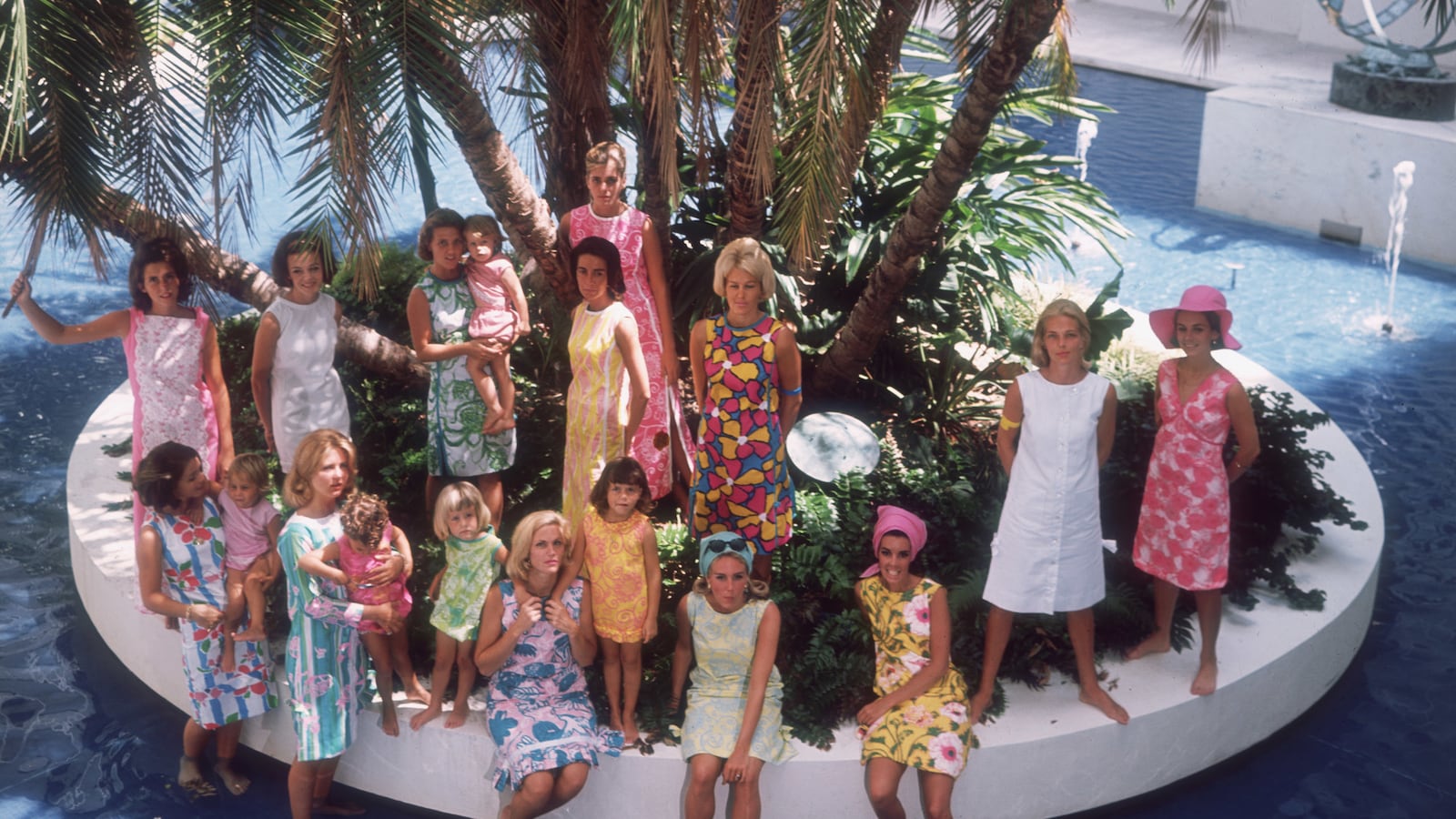
The designer and socialite Lilly Pultizer, who built an empire around brightly printed clothes, died Sunday at age 81 at her home in Palm Beach, Florida. “Lilly was a true original who has brought together generations through her bright and happy mark on the world,” her brand said of its founder in a post on its Facebook page.
With bold mixtures of pink and green and preppy explosions of tropical prints and colors and worn with tanned legs and blonde ponytails, Pulitzer’s dresses are recognizable everywhere. Her simple shift dresses became favorites for droves of socialites from Palm Beach to Greenwich, Connecticut, symbols of gorgeous, WASPy lives of leisure. “That’s what life is all about,” Pulitzer once said. “Let’s have a party. Let’s have it tonight.”
For the first 24 years, from 1959 to 1982, Pulitzer’s namesake company thrived. By ’82 annual sales were at $15 million. But it faltered in 1984, when designers like Calvin Klein and Donna Karan—and the hard-shouldered power suit—became popular for women. The brand went dormant until 1994, when it was revived by Sugartown Worldwide Inc. Pulitzer removed herself from the day to day but stayed involved as a consultant. Eventually the brand expanded to include children’s clothing, home furnishings, stationery, and even a limited line for men.
“Style isn’t just about what you wear, it’s about how you live,” Pulitzer once said. “We focus on the best, fun and happy things, and people want that. Being happy never goes out of style.”
She was born in 1931 with a silver spoon in her mouth—the daughter of Robert McKim and Lillian Bostwick, both from wealthy old-line families. She grew up with two sisters in Roslyn, New York, and attended The Chapin School and Miss Porter’s School for Girls. Instead of going to college, she worked as a nurse’s aide. In 1952 she eloped with Peter Pulitzer, grandson of Joseph Pulitzer—much to the surprise of family and friends. (According to a 2003 Vanity Fair profile of Lilly, her husband called her father to say: “I’ve just married your daughter.” To which he replied “Which one?”)
The couple settled in Palm Beach year-round, where they hosted glamorous barefoot dinner parties that turned into late-night dance parties. The handsome and debonair Pulitzer owned orange groves in central Florida, and the couple quickly became a fixture of the social circuit. Though they were private people, they made frequent appearances in the Palm Beach Social Register. They had three children, and eventually Lilly grew bored.
To keep busy, she sold oranges and grapefruits from her husband’s groves. At the end of every day, her clothes would be stained in pulp and juice, so she asked a seamstress to make her a shift dress so colorful that it would hide the juice stains. The Lilly Pulitzer dress was born.
Along with her friend Laura Clark, Pulitzer began to sell those dresses—one sleeveless version, and one with a sleeve—for $22. The first store opened on Worth Avenue in 1961. They became a runaway success with the women of Palm Beach. As Polly Mellen told Vanity Fair: “At this time ... it only exploded with a certain crowd. We’re discussing Palm Beach. We are not discussing Miami. We are discussing the Everglades Club, the Bath & Tennis Club, Palm Beach Hobe Sound—it’s today called the Jupiter Island Club. Lilly and Laura built a total status symbol.”
It was a status symbol within a world that cared about status symbols—and that counted for a lot. Pulitzer became the president of the company, her husband vice president, and Collins the secretary with a 25 percent stake. Pulitzer herself was the designer and visionary; because she liked going without underwear in the Florida heat, she built a lining into the dress so it wouldn’t become too see-through. According to a W magazine profile of the designer in 2008, Pulitzer was once told by a retailer that she needed to make fall clothes—to which she replied: “Oh, but you don’t understand, it’s always summer somewhere.”
Eventually everyone from Caroline Kennedy to Dina Merrill and Happy Rockefeller became fans of the brand. Jackie Kennedy appeared in Life magazine wearing the classic shift dress.
In 1969 the Pulitzers divorced, and soon after she married a handsome Cuban named Enrique “Caca” Rousseau, who had a sugar business. He died in 1993.
The business lost its footing in 1984, after Pulitzer tried to compete with the Calvin Kleins and Donna Karans that had become so popular in the 1980s. It hadn’t worked, and she filed for Chapter 11. In 1994 it was brought back to life by a pair of Harvard M.B.A.s—Scott Beaumont and James Bradbeer Jr. of Sugartown Worldwide Inc.—who were longtime fans of the brand. Under their direction, the company has thrived again, with more practical, office-friendly designs. It expanded into eyewear. (Pulitzer became a creative consultant for the brand.) In 2010 the company was bought for $60 million by Oxford Industries, which owns other labels like Tommy Bahama.
When Sugartown took over the company, it chose a slogan that fit Pulitzer’s outlook on life—and the Americanness of her brand. It was simply: “Love, Lilly, and the Pursuit of Happiness.”





